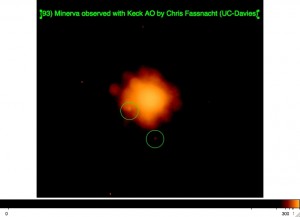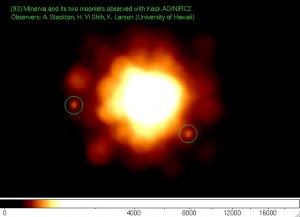The triple asteroid (93) Minerva – two additional observations!
I discovered the Galilean Satellites with my Galileoscope :-)
September 15, 2009Sponsoring my research. Any volunteers?
September 24, 2009I reported in August shortly after my observations at Keck Observatory, the discovery of two moonlets around (93) Minerva. As mentioned later, their existence were confirmed thanks to additional observations taken by J. Melnourne and K. Olsen. Now we enter in the most interesting part of my work which is the gathering of additional data to determine the orbital parameters of their mutual orbits (the orbits of the satellites around the primary asteroid).I just got two additional observations from generous and motivated Keck observers:
* While I was away this weekend, Chris Fassnacht, associate professor at University of California at Davies recorded one observation of Minerva at the end of his night. The two moons are clearly identified on the image attached below. Chris is primarily interested in measuring of cosmological parameters with gravitational lenses and extra-galactic astronomy in general. He is therefore at million light-years away of my field of research. Thanks Chris for taking this observation!

* Last night, Alan Stockton, professor at the University of Hawaii at the department of astronomy, and his graduate students, Hsin Yi Shih and Kirsten Larson, observed also Minerva at the end of their night. Alan group’s primary interest is the study of Quasars and early stage of Galaxy formation. They are also several billion light-years away from the study of our close environment and asteroids. Alan mentioned that his students were very enthusiastic with this project. The “seeing” (the quality of the sky linked with the atmospheric turbulence) was excellent during their observations and the moons are detectable even on the raw data (without any cosmetic processing). Thank you very much for agreeing to record this observation!



